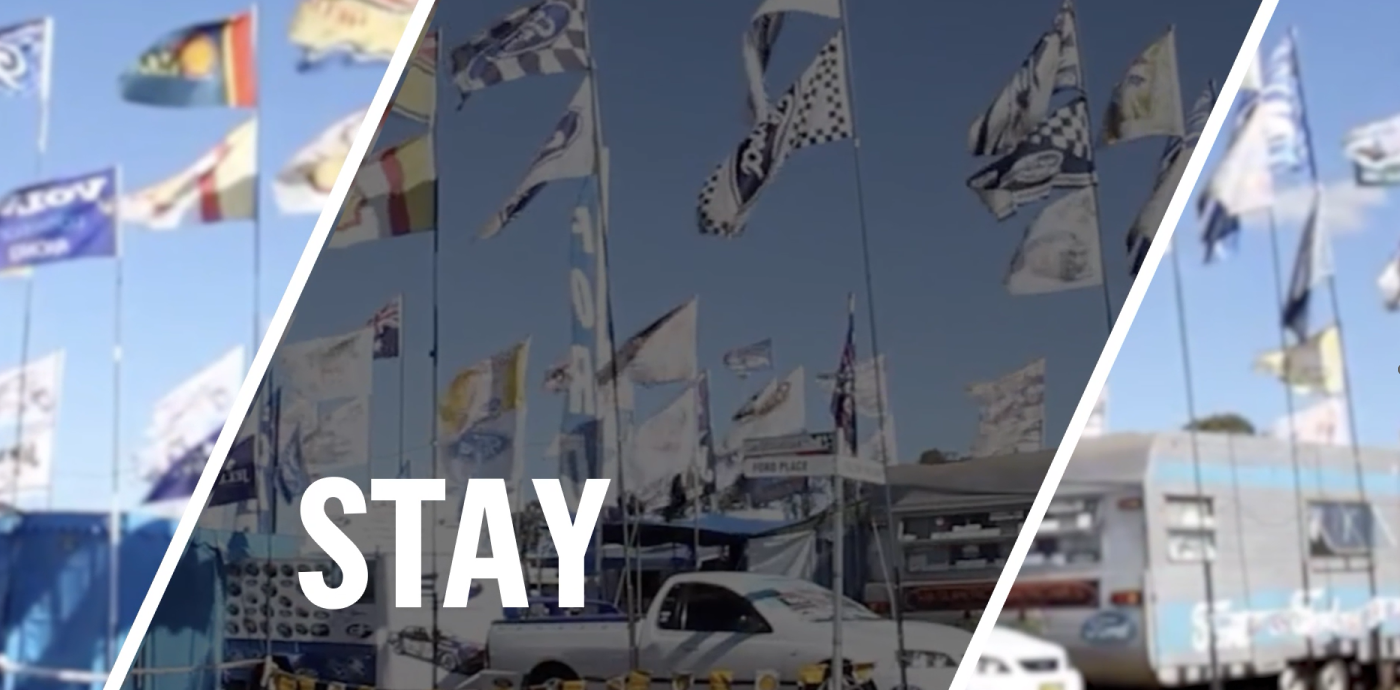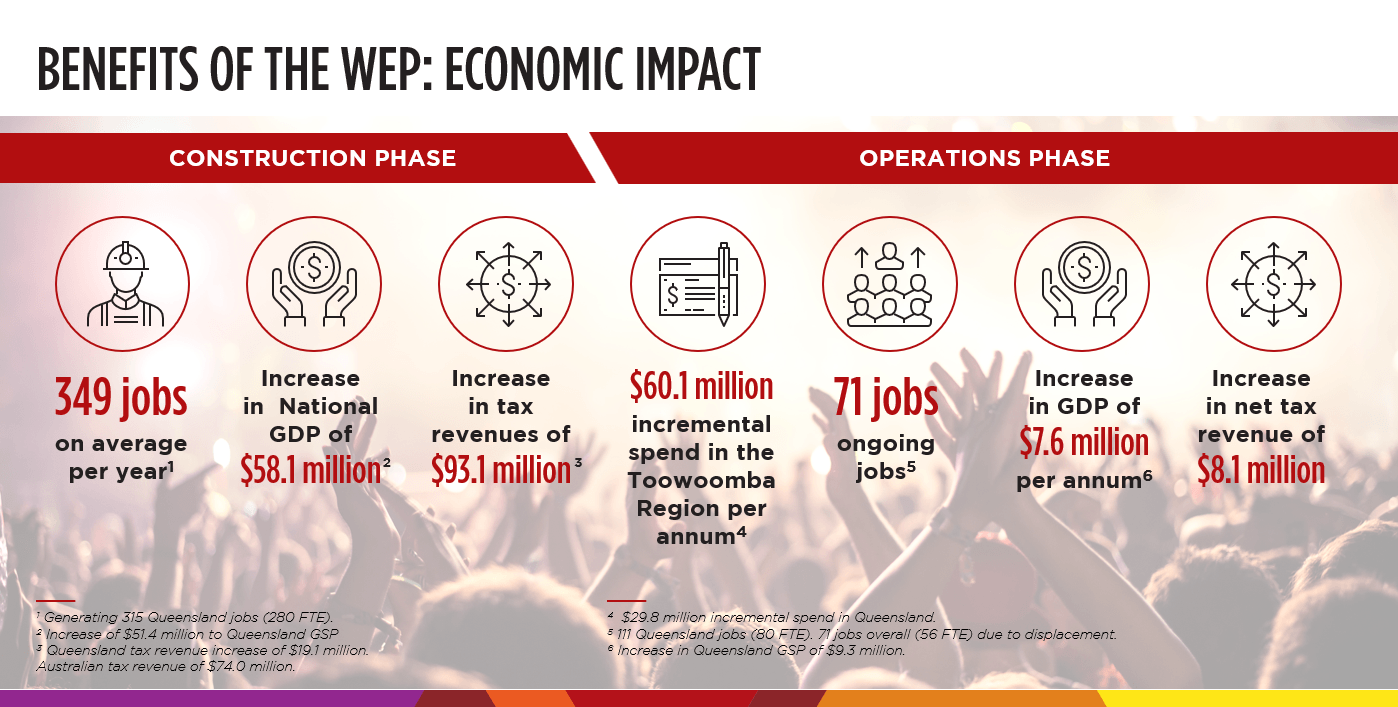
Slide title
Write your caption hereButton
Slide title
Write your caption hereButton
Slide title
Write your caption hereButton
Slide title
Write your caption hereButton
The Benefits of the WEP
FACILITY UTILISATION
The WEP is projected to be highly utilised, including:
- Hosting almost 30 motorsport and entertainment events per year, including major national and international events such as the V8 Supercars, the Shannon’s Motorsport Australia Championships, the Superkarts Australian Championships, the Australian Karting Championship, the Australian leg of the international Pro-MX GP, the Australian ProMX Championship, the Australian Supercross Championship and major music and festival events
- Attracting up to approximately 230,000 major event patrons per year
- Additional main track utilisation of over 100 days per year (approximately two days per week), including sports car training, exclusive user group sessions, corporate events, car / bike club events, manufacturer testing and product launches, et cetera
- Additional motocross / supercross track utilisation of approximately 130 days per year, including dirt bike clubs, corporate events, manufacturer testing and product launches, and casual track ride days
- At least 3,000 drivers annually participating in the various driver training excellence and safety programs delivered at the facility; and
- Potential Olympic Games supporting infrastructure
-
COST-BENEFIT ANALYSIS
A Cost Benefit Analysis (CBA) undertaken by KPMG for the WEP projected total incremental direct quantifiable economic benefits in the order of $173.71 in NPV terms, including benefits associated with increased tourism and major event expenditure, and benefits associated with the enhanced value gained by event patrons who are now able to attend premier events and event facilities within regional Queensland. When considered from the perspective of the State of Queensland (i.e. accounting for transfers across regions within Queensland), total incremental quantifiable economic benefits are projected to be in the order of $105.15 million in NPV terms.
KPMG specifically identified that the total projected incremental direct quantifiable economic benefits of the project to the Toowoomba Region are anticipated to be 4.72 and 2.35 times larger than the total quantifiable economic costs to be incurred by the Australian and Queensland Governments, respectively.
-
ECONOMY-WIDE IMPACT ASSESSMENT RESULTS
An Economy-wide Impact Assessment (EIA) was also undertaken for the WEP, incorporating both direct and indirect (flow-on) economic impacts of the project. The EIA considered both the short-term impacts during the construction phase of the project along with the average longer-run impacts of the steady-state operations of the WEP.
The construction phase impacts of the project (total impacts over the two-year construction period) are projected to be:
A total increase in Queensland Gross State Product (GSP) of $51.4 million;
- An increase in GSP across other Australian states of $6.8 million;
- An overall increase in Australian Gross Domestic Product (GDP) of $58.1 million;
- An increase in tax revenues to the Queensland Government in the order of $19.1 million;
- An increase in tax revenues to the Australian Government in the order of $74.0 million; and
- The generation of almost 350 jobs (direct and indirect) on average for each year of construction, including 315 jobs (equivalent to 280 FTE jobs) within Queensland and 34 jobs (equivalent to 31 FTE jobs) across the rest of Australia.
The operational phase impacts of the project (average impact in a steady-state year of operations) are projected to be:
- An annual increase in Queensland GSP of $9.3 million;
- An annual increase in Australian GDP of $7.6 million, reflective of a degree of displacement of economic activity away from other Australian states;
- An annual increase in tax revenues to the Queensland Government in the order of $8.1 million;
- The generation of 111 ongoing jobs (equivalent to 80 FTE jobs) within Queensland; and
- The generation of 71 ongoing jobs (equivalent to 56 FTE jobs) at the national level, is reflective of a degree of displacement of economic activity away from other Australian states
-
SOCIAL AND NON-QUANTIFIABLE BENEFITS
There are also numerous anticipated benefits of the WEP that are not able to be incorporated into a quantified economic analysis (CBA or EIA). These social or non-quantifiable benefits are equally important and form much of the rationale for investment by governments into projects of this nature. A summary of these benefits includes:
Improving access to entertainment and events for residents of Toowoomba, Queensland and regional Australia;
- Improving the liveability of a major regional Australian city, retaining workers and families in the region and attracting new residents to the region;
- Increasing the local, domestic and international brand recognition of Toowoomba and Queensland;
- Increasing employment and economic prospects of Toowoomba, enhancing business confidence and acting as a catalyst for new investment in the region;
- Establishing new participation and high performance pathways for motorsport in Queensland, including for drivers, officials, et cetera;
- Delivering enhanced training and skills for residents of Toowoomba and surrounds; and
- Improving driver and road safety, reducing the impact of road accidents across regional Queensland.

Collectively the WEP will support the Australian Government and Queensland Government deliver against their own objectives, strategies, policies and plans, including the Australian Government’s Regional Development Australia and Regions at the Ready initiatives, the Australian Government’s National Road Safety Strategy 2021-30 and the Queensland Government’s Unite & Recover and Skilling Queenslanders for Work strategies (among others).
Importantly, despite Wagner Corp providing the majority (62%) of capital funding for the project, much of the anticipated economic and social benefits of the project are likely to accrue to parties other than Wagner Corp. Wagner Corp’s commitment to the project is instead to deliver an important asset to act as a catalyst to the broader growth, diversification and sustainability of the Toowoomba economy as a key regional Queensland and regional Australian city.
